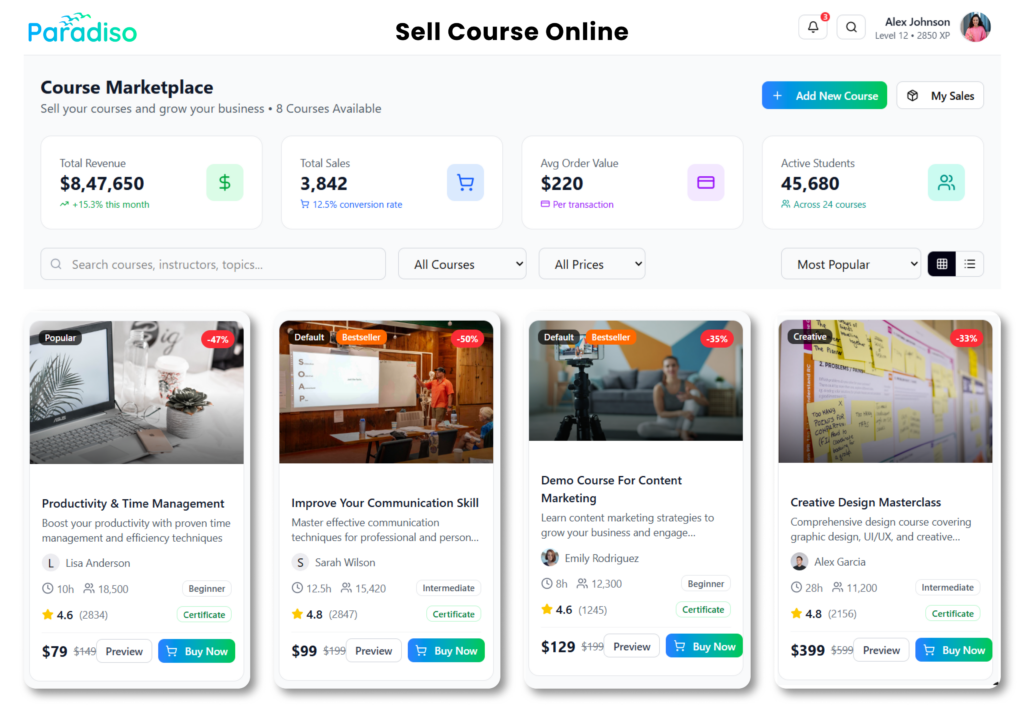When you integrate Salesforce with a Learning Management System, it can benefit you in various ways. Such as, it can help you monitor and analyze how well your employees are learning and developing new skills and make your operations smoother. The process of integrating these two systems involves six steps. The first step is determining what you expect from your LMS. Then, you must choose an appropriate customized LMS development platform according to your preferences. After that, you can create and integrate your customized LMS with Salesforce. Once everything is done, you must test, implement, and check its functionality. Also, you can combine your LMS with other systems to create a successful learning program.
Why Businesses Should Focus on Salesforce LMS Integration
Salesforce LMS Integration can give you valuable information about the courses and content your learners use. It also helps you understand your customer relationships better, which can improve your business and satisfy customer needs. By analyzing metrics like the frequency of user visits, engagement levels, awards or recognitions, and personalizing their learning experience, you can gain insights that help you grow your business.
Furthermore, you can establish a connection between the success of your product and customer training by ensuring that your customers fully understand your product/service. You can also provide customers with more information about your product/service through the LMS, helping them visualize future trends.
Benefits of Salesforce LMS Integration in Enhancing Customer Training Process
1.Effective data management
Creating new accounts for every new sales team member could need more time and effort. Integrating Salesforce with Paradiso LMS can significantly reduce such efforts. With this integration, when a new joiner is added to Salesforce, the LMS will automatically fetch the data and create a profile for them. Moreover, when employees show progress in their learning, the information in Salesforce will be automatically updated and shared with the LMS. As a result, it makes it easier for the administrator to manage just one system while ensuring that all the courses relevant to each employee are tracked and maintained correctly.
2.Ensuring Transparency in Training
Learning a new system can take time and impact your course completion rate. To make it effortless, Salesforce LMS integration allows you to access your course via the Salesforce account interface on your familiar tab. It applies to both sales and customer training and enables learners to save time by not becoming familiar with new interfaces. Additionally, LMS with Salesforce integration tracks learners’ performance and generates reports.
3.Advances Student’s Learning Path
With the help of a Salesforce LMS Integration, you can provide your customers with social learning opportunities. This online platform enables learners to review and discuss the material with their peers, facilitating knowledge retention and interaction among classmates. In addition, customers can preview upcoming programs as the Salesforce LMS integration recommends future coursework based on their previous learning.
4.Easy to Monitor Learners’ Progress Reports
The Salesforce LMS integration enables administrators to monitor Learners ‘ educational progress and receive notifications when a program is finished or when credits, certificates, or credentials are obtained. This feature allows course analytics such as registrations, completions, engagement patterns, customer training performance, and program evaluation ratings to be easily viewed.
5.Identify areas of improvement
With Salesforce LMS integration, you can effectively detect areas of improvement in performance and skills, especially regarding customer service matters. For instance, you can review reports on customer training and analyze the resources they access frequently. In addition, it offers valuable insights into which products they are interested in and which information they may lack.
5 Essential Steps to Effortlessly Integrate an LMS with Salesforce
How do you connect a personalized LMS (Learning Management System) with Salesforce? Here are six steps that thoroughly explain the process of integration:
Step 1: Determine the needs and preferences of Your Personalized LMS
Establishing the objectives and necessities of your personalized LMS before beginning the integration process is crucial. For example, what are the primary goals of your learning program, and who is your target audience with their specific requirements and preferences? What content and evaluations would you like to incorporate into your LMS? By answering these questions, you can identify the scope and necessities of your custom LMS to fulfill your business and learners’ needs.
Step 2: Select an Appropriate LMS development platform Based on Your preferences
Several LMS development platforms are available to create a customized LMS, such as Paradiso LMS. It has unique features and benefits, and the one you pick will depend on your needs and requirements. When selecting a platform to develop a custom LMS, it’s essential to consider factors such as the complexity of your learning program, the size of your organization, and your budget. It will help you choose the best platform that suits your requirements and is budget friendly.
Step 3: Design and construct your personalize LMS
After selecting a personalized LMS development platform, the next step is designing and constructing the LMS. It usually entails creating the LMS’s user interface, course framework, and content. Additionally, you may have to develop custom integrations and plugins to enhance the functionalities of your LMS.
Step 4: Use Salesforce API to Integrate With your Personalize LMS
Using the Salesforce Application Programming Interface to integrate your personalized LMS with Salesforce would be best. It will allow you to establish a link between your LMS and the Salesforce platform and enable data exchange. There are various options available for integrating Salesforce LMS, including custom integrations, third-party integrations, and pre-built integration tools. The choice of integration method will depend on your specific requirements and available resources.
Step 5: Test and Implement Your Personalize LMS To Check Its Functionality
Before releasing your customized LMS, it’s crucial to conduct comprehensive testing to verify its functionality and ensure that it satisfies all your business needs. This testing may involve user acceptance and functional and performance testing. After thoroughly testing your LMS and addressing any concerns, you can roll it out to your learners and employ it for your learning and development initiatives.
Why should someone choose Paradiso LMS for Salesforce Integration?
1.Easy to Use and Manage With Paradiso LMS
Paradiso LMS makes it easy to manage your learning activities. Our intuitive dashboard lets you quickly and easily monitor learners and track performances. Our platform also offers advanced reporting capabilities to see how learners progress and measure their success. Additionally, our platform is customizable and scalable, so you can easily adjust the platform to meet your specific needs.2.Seamless Integration With Your Existing Systems
Paradiso LMS is designed to integrate with your existing systems flawlessly. Our integration is secure, reliable, and easy to use, so you can rest assured that your data is safe and secure. Plus, our integration is customizable and scalable, so you can easily adjust the platform to meet your unique needs.3.Secure and Reliable Learning Platform
We understand the importance of security and reliability. Our platform is secure and reliable, so you can rest assured that your data is safe and secure. Plus, our platform is designed to meet the highest industry standards for security and reliability, so you can trust that your learners’ data is securely protected.4.Powerful Reporting and Analytics
Paradiso LMS offers advanced reporting and analytics capabilities to monitor progress and track activities easily. Our platform also offers customizable dashboards, so you can easily view and analyze data in real time. Plus, our platform is designed to meet the highest industry standards for reporting and analytics, so you can trust that your data is accurate and up to date.Final Thoughts:
Integrating Salesforce with Paradiso LMS can bring numerous benefits to your training programs. The integration streamlines the training process, consolidates data, and enables you to leverage powerful reporting and analytics capabilities. With this integration, you can obtain actionable insights into customer behavior, optimize your training initiatives, and generate revenue. Overall, integrating Salesforce with Paradiso LMS simplifies training management, making it a more efficient and effective process.














